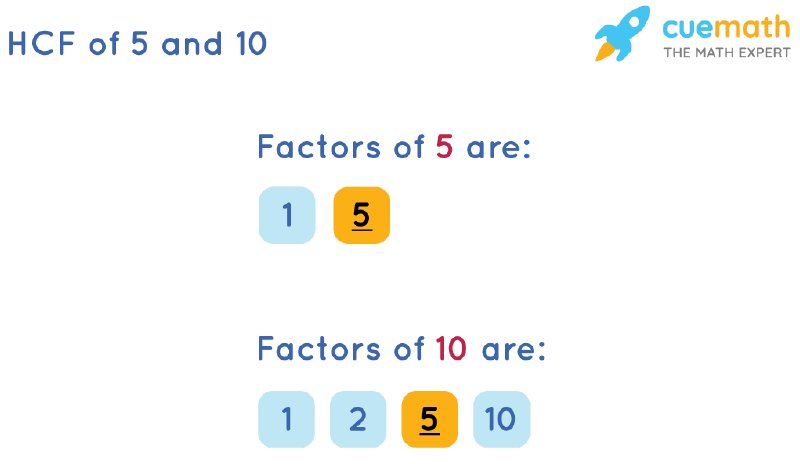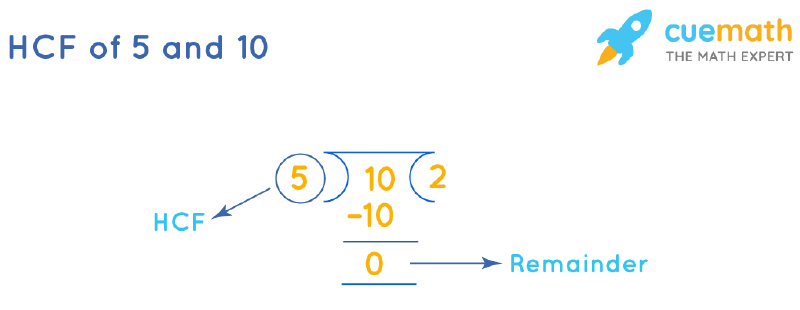HCF of 5 and 10
HCF of 5 and 10 is the largest possible number that divides 5 and 10 exactly without any remainder. The factors of 5 and 10 are 1, 5 and 1, 2, 5, 10 respectively. There are 3 commonly used methods to find the HCF of 5 and 10 - long division, Euclidean algorithm, and prime factorization.
| 1. | HCF of 5 and 10 |
| 2. | List of Methods |
| 3. | Solved Examples |
| 4. | FAQs |
What is HCF of 5 and 10?
Answer: HCF of 5 and 10 is 5.

Explanation:
The HCF of two non-zero integers, x(5) and y(10), is the highest positive integer m(5) that divides both x(5) and y(10) without any remainder.
Methods to Find HCF of 5 and 10
The methods to find the HCF of 5 and 10 are explained below.
- Listing Common Factors
- Long Division Method
- Prime Factorization Method
HCF of 5 and 10 by Listing Common Factors

- Factors of 5: 1, 5
- Factors of 10: 1, 2, 5, 10
There are 2 common factors of 5 and 10, that are 1 and 5. Therefore, the highest common factor of 5 and 10 is 5.
HCF of 5 and 10 by Long Division

HCF of 5 and 10 is the divisor that we get when the remainder becomes 0 after doing long division repeatedly.
- Step 1: Divide 10 (larger number) by 5 (smaller number).
- Step 2: Since the remainder = 0, the divisor (5) is the HCF of 5 and 10.
The corresponding divisor (5) is the HCF of 5 and 10.
HCF of 5 and 10 by Prime Factorization

Prime factorization of 5 and 10 is (5) and (2 × 5) respectively. As visible, 5 and 10 have only one common prime factor i.e. 5. Hence, the HCF of 5 and 10 is 5.
☛ Also Check:
- HCF of 12, 45 and 75 = 3
- HCF of 84 and 120 = 12
- HCF of 1152 and 1664 = 128
- HCF of 10, 20 and 30 = 10
- HCF of 12576 and 4052 = 4
- HCF of 777 and 1147 = 37
- HCF of 17 and 19 = 1
HCF of 5 and 10 Examples
-
Example 1: Find the HCF of 5 and 10, if their LCM is 10.
Solution:
∵ LCM × HCF = 5 × 10
⇒ HCF(5, 10) = (5 × 10)/10 = 5
Therefore, the highest common factor of 5 and 10 is 5. -
Example 2: The product of two numbers is 50. If their HCF is 5, what is their LCM?
Solution:
Given: HCF = 5 and product of numbers = 50
∵ LCM × HCF = product of numbers
⇒ LCM = Product/HCF = 50/5
Therefore, the LCM is 10. -
Example 3: For two numbers, HCF = 5 and LCM = 10. If one number is 5, find the other number.
Solution:
Given: HCF (z, 5) = 5 and LCM (z, 5) = 10
∵ HCF × LCM = 5 × (z)
⇒ z = (HCF × LCM)/5
⇒ z = (5 × 10)/5
⇒ z = 10
Therefore, the other number is 10.

FAQs on HCF of 5 and 10
What is the HCF of 5 and 10?
The HCF of 5 and 10 is 5. To calculate the HCF (Highest Common Factor) of 5 and 10, we need to factor each number (factors of 5 = 1, 5; factors of 10 = 1, 2, 5, 10) and choose the highest factor that exactly divides both 5 and 10, i.e., 5.
How to Find the HCF of 5 and 10 by Prime Factorization?
To find the HCF of 5 and 10, we will find the prime factorization of the given numbers, i.e. 5 = 5; 10 = 2 × 5.
⇒ Since 5 is the only common prime factor of 5 and 10. Hence, HCF (5, 10) = 5.
☛ What is a Prime Number?
What is the Relation Between LCM and HCF of 5, 10?
The following equation can be used to express the relation between LCM (Least Common Multiple) and HCF of 5 and 10, i.e. HCF × LCM = 5 × 10.
How to Find the HCF of 5 and 10 by Long Division Method?
To find the HCF of 5, 10 using long division method, 10 is divided by 5. The corresponding divisor (5) when remainder equals 0 is taken as HCF.
If the HCF of 10 and 5 is 5, Find its LCM.
HCF(10, 5) × LCM(10, 5) = 10 × 5
Since the HCF of 10 and 5 = 5
⇒ 5 × LCM(10, 5) = 50
Therefore, LCM = 10
☛ HCF Calculator
What are the Methods to Find HCF of 5 and 10?
There are three commonly used methods to find the HCF of 5 and 10.
- By Long Division
- By Listing Common Factors
- By Prime Factorization
visual curriculum
